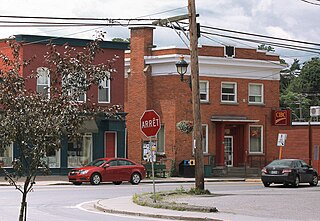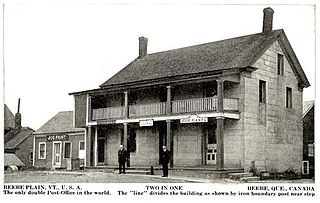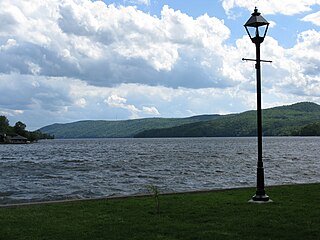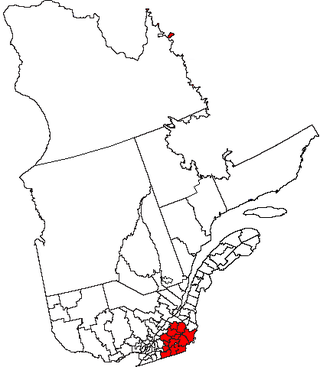
The Connecticut River is the longest river in the New England region of the United States, flowing roughly southward for 406 miles (653 km) through four states. It rises 300 yards south of the U.S. border with Quebec, Canada, and discharges at Long Island Sound. Its watershed encompasses 11,260 square miles (29,200 km2), covering parts of five U.S. states and one Canadian province, via 148 tributaries, 38 of which are major rivers. It produces 70% of Long Island Sound's fresh water, discharging at 18,400 cubic feet (520 m3) per second.

Stanstead is a town in the Memphrémagog Regional County Municipality in the Estrie region of Quebec, located on the Canada–United States border across from Derby Line, Vermont.

Magog is a city in southeastern Quebec, Canada, about 120 kilometres (75 mi) east of Montreal at the confluence of Lake Memphremagog—after which the city was named—with the Rivière aux Cerises and the Magog River. It is a major centre and industrial city in the Regional County Municipality of Memphremagog. The city lies in the Eastern Townships tourist region.

Beebe Plain is an unincorporated community in the town of Derby in Orleans County, Vermont, United States, which extends into the municipality of Stanstead, Quebec, Canada. The village is divided by the Canada–United States border between Canada and the United States; the Canadian portion of Beebe Plain had the status of an incorporated municipality in its own right until 1995.

Potton is a township municipality of about 2,010 people in the Memphrémagog Regional County Municipality. It is located on the western shore of Lake Memphremagog in the Estrie region of Quebec, and is one of the municipalities in Brome County. Potton is located about 125 kilometres (78 mi) southeast of Montreal, 30 kilometres (19 mi) to the southwest of the city of Magog, and next to the United States border, north of North Troy, Vermont.
Compton was a federal electoral district in Quebec, Canada, that was represented in the House of Commons of Canada from 1867 to 1949, and again from 1968 to 1997.

Lake Memphremagog is a fresh water glacial lake located between Newport, Vermont, United States and Magog, Quebec, Canada. The lake spans both Quebec and Vermont, but is mostly in Quebec. Most of the watershed that feeds the lake is located in Vermont, and is a source for accumulated phosphorus, sediments, and other pollutants. Cleanup efforts since the late 1980s have improved the water quality. The lake furnishes potable water for 200,000 people.

Ayer's Cliff is a village municipality in the Memphrémagog Regional County Municipality in the Estrie region of Quebec. It is located just north of the Canada–United States border, on Lake Massawippi, near the mouth of the Tomifobia River.

Route 247 is a north/south highway on the south shore of the Saint Lawrence River in the Estrie region of Quebec. Its northern terminus is in Magog at the junction of Route 112 and its southern terminus is in Stanstead, at the junction of Autoroute 55 less than 1 kilometre north of the Canada–United States border.

Beebe Plain is an unincorporated geographically-contiguous settlement, split politically between Canada and the United States. An unincorporated village partially in Stanstead and partially in Derby Line, it is divided by the Quebec-Vermont border. This settlement was begun by David and Calvin Beebe in 1798.

Lake Massawippi is a freshwater lake in Memphrémagog Regional County Municipality in the Estrie region of Quebec, Canada. The Tomifobia River is the source of the lake at its southern tip, near the village of Ayer's Cliff, Quebec. In early records, the lake was also called "Lake Tomifobi". The current of the lake flows north, funneling into the Massawippi River at the village of North Hatley, Quebec on Massawippi's northern shore.

The Tomifobia Nature Trail is a 19 km rail trail in the Eastern Townships region of Quebec. It follows the old route of a Canadian Pacific railway from Ayer's Cliff to Stanstead. In between, it passes through parts of Stanstead-Est, Stanstead Township, and Ogden.
Beebe Plain is a divided village on the Quebec-Vermont border.

The Massawippi River is a river flowing in the territory of North Hatley and the city of Sherbrooke, in the administrative region of Estrie, in Quebec, Canada. It is a tributary of the Saint-François River which flows north to the south shore of the Saint Lawrence River.

The Beebe Plain–Beebe Border Crossing is a border crossing station on the Canada–United States border. It connects Rue Principale in Beebe Plain, Quebec with Beebe Road in Beebe Plain, a village in Derby, Vermont. Both the US and Canadian station buildings are historical properties listed by their respective governments.
The Massawippi Valley Railway was a short line railway established in 1870 between Lennoxville, Quebec, and the Vermont border. Part of the Quebec Central Railway from 1926, the line was abandoned in 1990 and removed in 1992. Most of the former railway's right of way is now used for bicycle trails.

The Coaticook River is a north-flowing river rising in Vermont, United States, and located primarily in the Estrie region of Quebec, Canada. The mouth of the river is located north of Waterville and south of Lennoxville, near the southern border of the city of Sherbrooke, at the Massawippi River. Via the Massawippi and the Saint-François River, it is part of the St. Lawrence River watershed.
Johns River is a tributary of the Lake Memphremagog, flowing in the municipality of Derby in northern Vermont, in United States and in the municipality of Stanstead (city), Quebec in the Memphremagog Regional County Municipality (RCM), in the administrative region of Estrie, south of Quebec, in Canada.

The Niger River is a tributary of the Tomifobia River. The Niger River flows successively in the municipalities of Coaticook, Barnston-Ouest, Stanstead-Est and Hatley, in the Memphrémagog Regional County Municipality (MRC), in the administrative region of Estrie, in Quebec, in Canada.


















